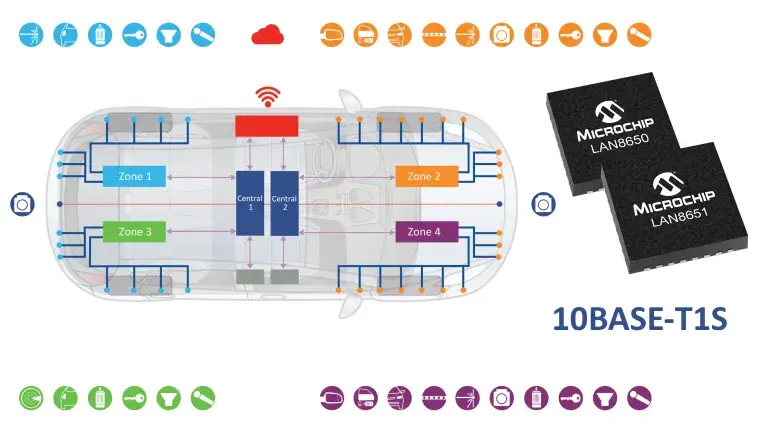
Microchip’s LAN8650/1 MAC-PHYs with a built-in MAC and SPI connect MCUs without a built-in Ethernet MAC to a 10BASE-T1S Ethernet network.
Microchip Technology Inc. recently announced a new family of automotive-qualified LAN8650/1 MAC-PHYs with a built-in media access controller (MAC) and serial peripheral interface (SPI) that allows designers to connect 8-, 16- and 32-bit microcontrollers (MCUs) without built-in Ethernet MACs to 10BASE-T1S Ethernet networks.
“This allows sensors and actuators that interface between the digital and the real world to become part of an all-Ethernet architecture,” said Microchip.
In addition, connection even to simple MCUs can reduce the overall size and cost of a design, said the company.
The 10BASE-T1S technology enables automotive designers to create new zonal architectures in automotive applications and allows low-speed devices to connect to a standard Ethernet network, eliminating the need for dedicated communication systems, said Microchip.
Microchip's LAN8650/1 MAC-PHYs automotive application
10BASE-T1S expands Ethernet to the edge of operational technology (OT) and information technology (IT) networks, despite a network of incompatible devices and different physical hardware. For automotive, it provides a 10 Mbits/s, multi-drop transmission medium that can include up to eight transceiver nodes. The transceiver nodes connect to a common mixing segment of up to at least 25 m.
10BASE-T1S lowers total system cost by using a single pair of wires and the multi-drop bus architecture, while increasing system scalability, said Microchip. Several nodes operate on the same bus line with high data throughput and the system requires fewer switch ports, cables and switches.
Key features of the LAN8650 and LAN8651 include a MAC and SPI to connect devices at the edge of automotive networks; time-sensitive networking (TSN) support, which allows for synchronized timing critical for many automotive applications including advanced driving assistance systems (ADAS) and compliance with the AEC-Q100 Grade 1 qualification standard. The devices also feature an extended operational temperature range from −40°C to 125°C and they are functional safety ready for use in ISO 26262 applications.
Ethernet solutions are important in automotive applications given their well-established security protocols for keeping network systems secure. These systems can be extended to the edges of the network without extensive changes or new development.
The LAN8650/1 MAC-PHYs are currently available and are supported by a set of network analysis tools, a LAN8651 SPI Evaluation Board and MPLAB Harmony 3 to help with the design process.



